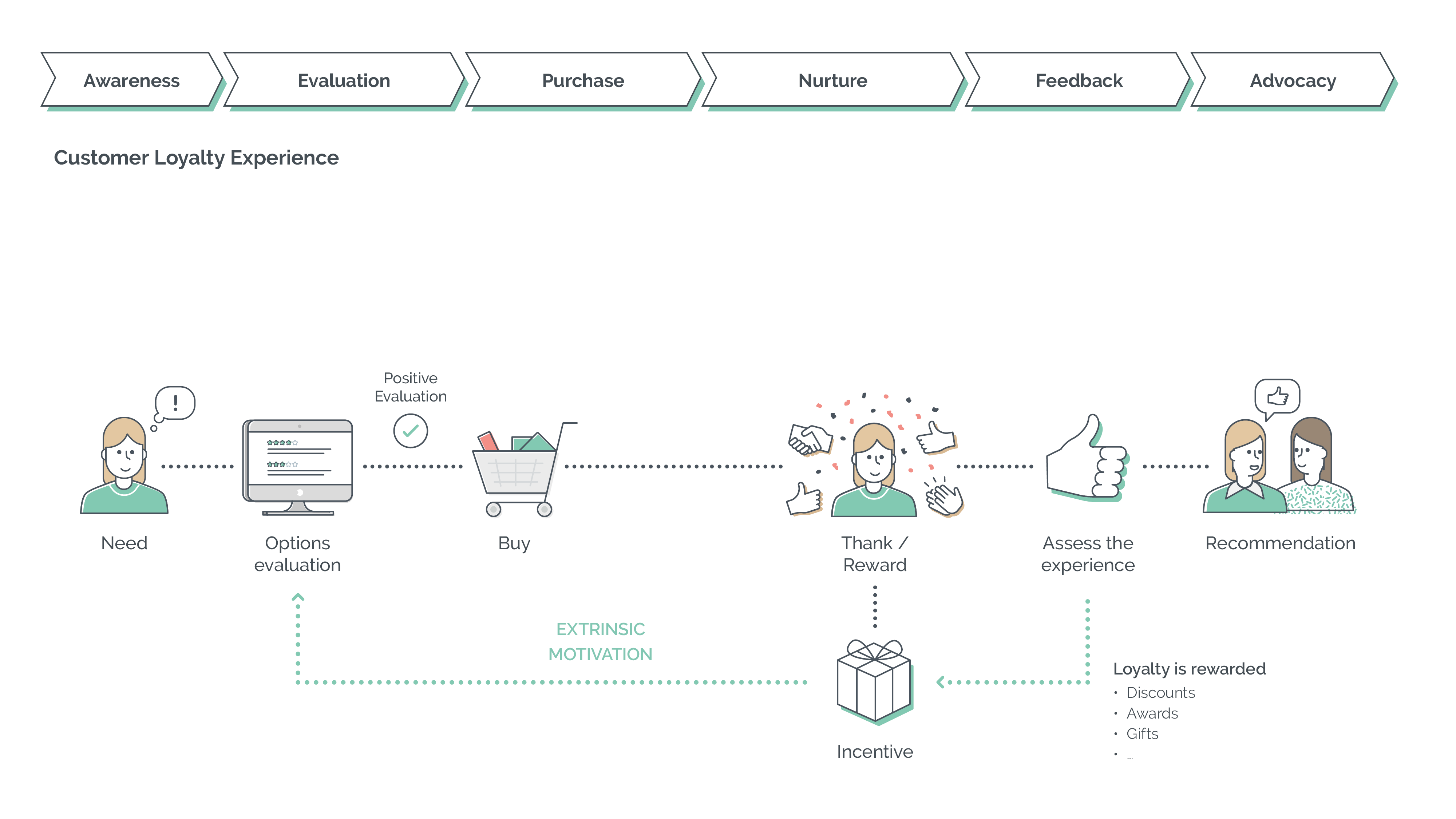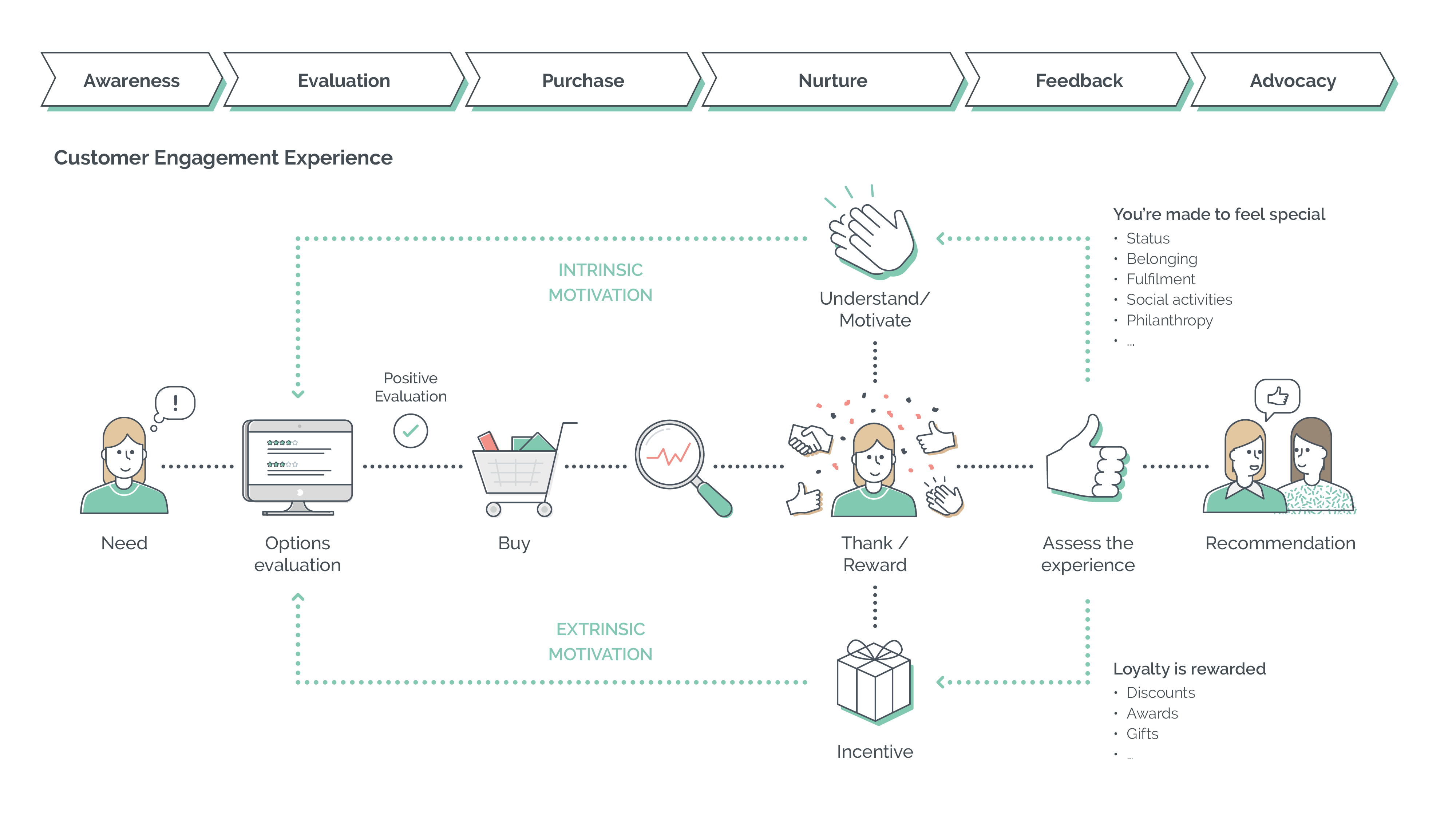CATEGORY
ENGAGEMENT
Brands are constantly fighting for consumer attention, relevance and profitability against a backdrop of intense disruption and competition. It would be superficial to claim consumer’s today are easily influenced or swayed, when the reality is that most are looking to be impressed by seamless accessibility and browsing, won over by considered brand values and communications, and excited by excellent customer service and stand-out experiences. Capturing their attention is a crucial part of the journey, but strong Customer Engagement strategies should also be sustaining engagement, retention, and advocacy to truly reinforce profitability and performance.
Successful loyalty programs develop Customer Engagement beyond transactional relationships which are incentive focused but weak on lasting engagement. This is often due to the overall offering lacking personalisation, relevance, or user centricity. Customer Engagement strategies that do well in hooking and retaining their audiences provide a richer, multi-faceted offering that directly appeals to user needs and drives.
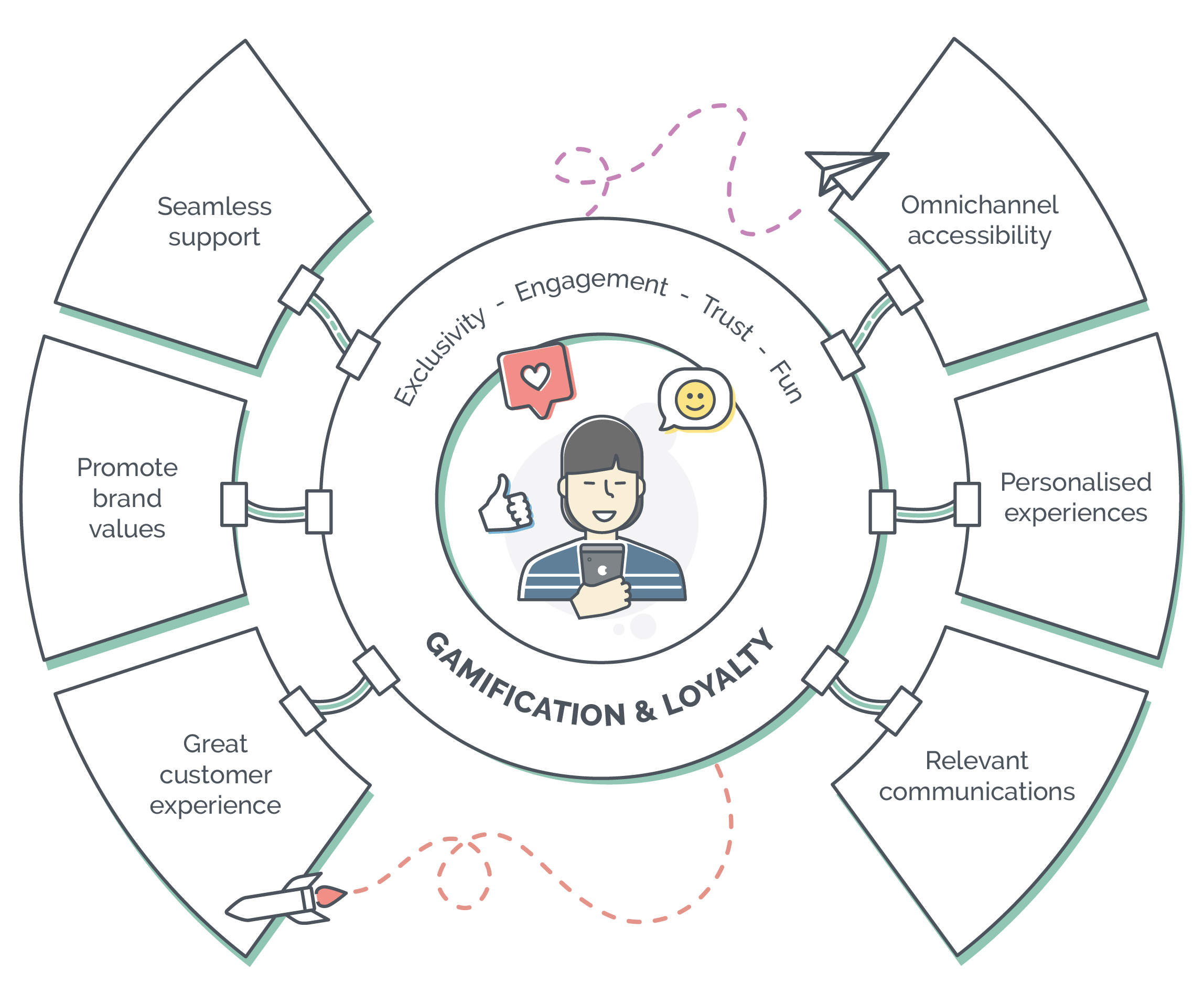
To deliver this, you of course need a strong technological foundation to support seamless, omnichannel accessibility. You need an attractive product or service offering, well showcased through intuitive and creative design work. You need an insightful understanding of the end user or customer, in order to provide communications and touchpoints that build trust. But how can you enhance the experience, in a way that still authentically represents your brand, to help the customer fall just that bit more in love?
63% of loyalty members say that if they enjoy an experience, they will use it more. Great Customer Service: 75% of loyalty members say they would stop using a program if they experience poor service. Brand Values: 70% of consumers feel it is important that brands uphold values that they have an emotional attachment to.
A strategy that can make a big difference to sustainable user enjoyment and effectively transmit information is Gamification: the application of game design, game elements and play in non-game contexts – such as brand apps or member schemes.
Why Add Gamification?
At first glance, Gamification could be easily sorted into the camp of shallow gimmicks. Is the idea not to move beyond just incentivising? However, as with AI or VR or any innovative functionality you’re looking to design into a process or experience, the result is highly dependent on the ‘why’, the ‘what’ and the ‘how’. So let’s break it down.
Fun and enjoyment seem such obvious elements to include in your offering to customers, and yet so often aren’t designed into experiences. If you want customers to love your brand, if you want to be the first place they look, if you want to bolster recurring purchases, you need to seriously think about how to find ways to make them enjoy the relationship more.
Games, by nature, are fun. Everyone will have types they prefer more than others, and some that they really dislike, because games create emotional and behavioural responses within us. Who hasn’t seen their competitive side suddenly awakened by a game? Or maybe you love building or exploring new worlds? Gamification is often misconstrued as ‘just adding a game’ to something. The theory is actually about applying game elements or game-like design into non-traditional settings in order to make them more enjoyable, or to create more of an emotional reaction from participants. We have all seen how games can create buzz, but gamification can also make a program more attractive or even teach critical messages in a fun and engaging way (learn through play).
Techvalidate showed that 30% of companies using gamification improved registration conversion rates by upward of 50%. Tapping into people’s need for enjoyment, or even curiosity to see what the fuss is all about, is a really easy starting place for applying gamification to a loyalty or membership scheme. For example, attractive but short games can be hosted seasonally to encourage exploration of new collections or messages, as fun, exclusive, personalised experiences that exemplify the brand values and bring the customer just that bit closer.
Keep Them Coming Back For More
Of course, many loyalty programmes already use a very simplistic gamification strategy to encourage interactions: points and rewards. Rewards schedules are essential to any loyalty scheme but consumers today expect more from their customer experience than “spend more to get more” point systems. Plus, through these purely transactional approaches, you’re not actually rewarding loyalty, you’re rewarding spending. Some customers will desperately want to be part of a brand’s circle because they’re inspired by the brand values or imagery but may not always have the cash to splash frequently enough to be rewarded. Loyalty schemes can immediately become more personal by remembering and recognising special occasions, such as a customer’s birthday or membership anniversary. Game design can then also help members understand what behaviours can be rewarded or give them the chance to boost points or bring themselves closer to new membership levels or treats.
Random rewards, like Easter Eggs, can also add elements of surprise and delight and give customers a reason to log into their account to see if they’re in luck that day. Random promotions, offers and communications that speak to them can help energise the connection between customer and brand.
Gamification can also be applied to boost social connection within a programme, allowing and encouraging and rewarding people for inviting friends to join. Programmes that allow you to create teams or groups can have two benefits – while it obviously helps to bring new members into the scheme, more importantly for the customer it creates a bond and shared experience with friends. Just like games are always more fun when playing with a group of friends, either playing against each other or competing together for a prize helps foster natural and enjoyable ways to improve interactivity within a loyalty scheme.
Creating Emotional Reactions to Drive Behaviour Change – RAMP
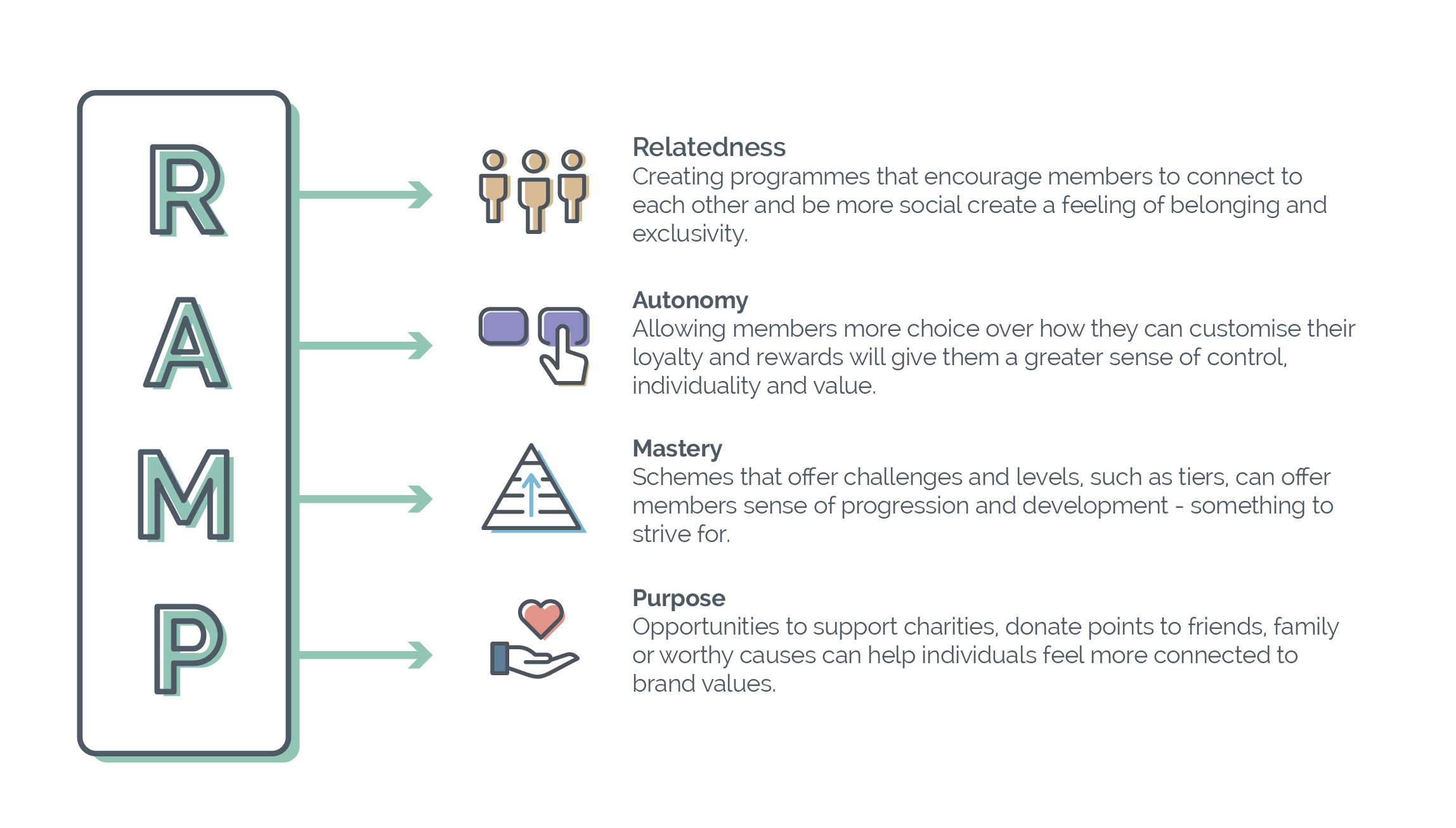
Appealing to Your Audience
More ways to boost the social element within a program, that have become increasingly popular – providing seamless connections and pathways to social media platforms. Encouraging customers to share their shopping experiences with their networks and actually rewarding and recognizing their Instagram posts, Tweets or Facebook reviews/recommendations, is a fast way to nurturing brand advocates or at least a much more meaningful connection between customer and brand. Furthermore, people are always more inclined to purchase when they can relate to the ambassadors they see on the brand website, apps, and of course social media. In the age of the influencer, incentivizing and enabling people to share their own positive experiences will help build communities and foster a sense of belonging and exclusivity for members whose feedback or interactions get featured.
Game elements that can enhance the sensation can be quite simple but effective, such as tiered reward systems where members unlock different experiences, offers or access, or even a more personalised approach where members can choose the membership or profile that suits their style, needs or requirements. You can even take this further by allowing customers to fully personalise their reward system, offering not only rewards related to the brand but more experiential rewards – leisure activities and the like. Again, this makes them feel they have more control of their preferences and options within the loyalty scheme, making it more tailored to them as individuals.
Ultimately, it is important to design with the user in mind. No one is interested in playing a game where they’re not able to succeed or participate fully, or that feels it is weighted against them. If you just apply a game with no meaning or relevance, you’ll risk abandonment, just like designing an app without considering how people need to use it. Considering what will drive them to brand loyalty and advocacy, or how to improve the journey to purchase, but also making sure they feel they’re in control of their membership rather than at the mercy of an elusive brand, or just another number on a platform.
The opportunity to buy almost anything from anywhere without needing access to a desktop device has been a transformational development to the world of online commerce. So much so that mobile currently represents a 72.9% share of total e-commerce spend, up from 58.9% in 2017.
Whether hospitality, retail, or mobile banking: M-Commerce apps are levelling up and developing more paths to take customers from inspiration to sale as efficiently as possible. Through functional improvements, deep linking, and influencer marketing, social media has started shaping a new approach to ‘window’ shopping, and m-commerce strategies are recognising the need to intertwine and integrate across platforms we use all day every day, especially those most frequently accessed via mobile devices. Through the click of one interactive “buy button” on sites such as Facebook, Pinterest and Instagram, we can make in-app third party purchases without even having to leave the platform.
The benefits to investing in and curating m-commerce are evident. Through direct, push-notification style communications companies can reap the rewards and leverage more accurate location tracking utilising GPS and cellular connections through mobiles rather than solely depending on computer IP addresses to provide more targeted communications and experiences. Consumers benefit from the added convenience and immediacy – but is it enough to keep them interested?
Efficiency is vital for supporting the journey to sale. It is like laying down the road that you’ll take people on or providing the vehicle. What is also important, however, is the direction, guidance, drive and inspiration that will take them towards the end goal. Customers today have endless options and distractions available to them, but they also have much more developed values and expectations than what many brands perceive. Can’t find what you’re looking for? App glitching? Awkward navigation? Visuals don’t speak to you? There are hundreds of alternatives that could give you the successful experience you’re looking for. Because of its very position in the palm of the consumers hand m-commerce channels can play a valuable role beyond being another window to shop from by showcasing how brands understand and enable the individual. Achieving this requires much more nuanced design and a genuine understanding of customer needs, and without it, well, you’ve just got an app.
So how can you make sure your m-commerce strategy transcends beyond being just the app version of your brand website or store?
Omnichannel
It’s easy to come to the conclusion that the solution to all problems is to provide an app, but sometimes a bad app is worse than no app at all. M-commerce is a core interface for the modern consumer, but it should not stand alone from other touchpoints with a brand or company. A detached strategy will only frustrate users as they try to move between environments. If a user falls in love with your app but is hugely disappointed when they can’t make returns via the website and the store doesn’t recognise their membership account, you’ve created an even higher chance of turn off or abandonment.
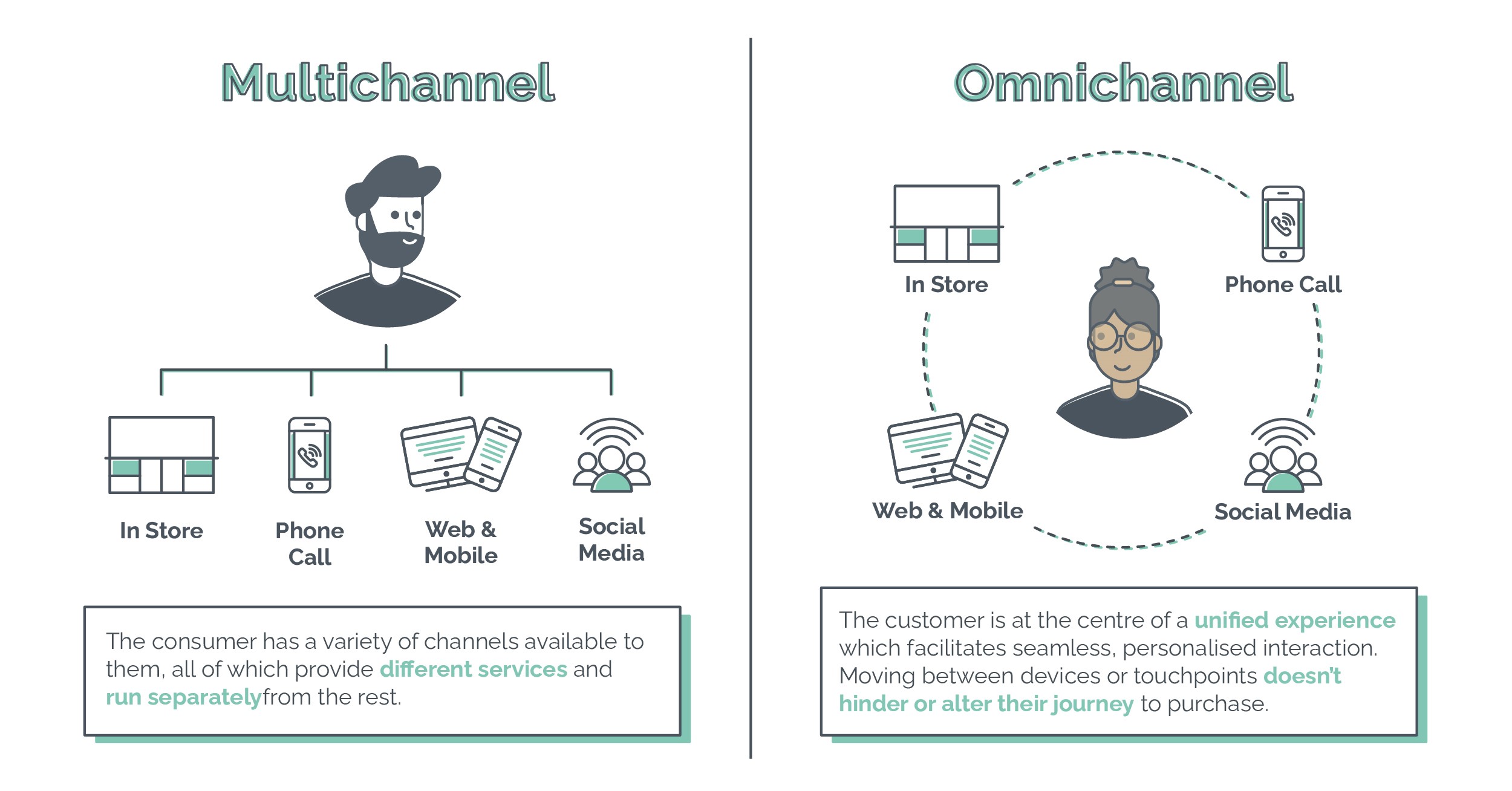
Omnichannel isn’t about just having different channels. It’s about creating a seamless, connected shopping experience across those multiple channels, supporting and sustaining the process whenever, wherever, and however the consumer wants to continue. Consumers want a balance of in-person experiences and the convenience of online, and an omnichannel strategy ensures brand consistency, broadens a customer’s choice and boosts their experience. Through a unified approach, you can improve and multiply the ways customers can successfully interact with your brand. It can ultimately emotionally impact the customer in ways we’ve all experienced at one point in time. Imagine someone spots something they like when browsing on their laptop during a lunch break and save it to their basket or favourites before being interrupted, returning to the site via their app on the train home. They’re relieved to see it’s still saved where they left off earlier and make the purchase choosing free pick up in store option. Finally, when they pick up their order the next day they see a 2 for 1 offer on something they’re low on, and while of course the brand immediately benefits from the flow of incidents, the customer walks away fulfilled having enjoyed the experience as if everything worked in their favour.
Safe and Secure
When it comes to any type of online commerce, safety and security is undoubtedly one of the biggest, and most concerning problems. It just takes one inconvenient and complicated payment experience for a potential customer to abandon their basket and seek alternatives elsewhere. We all know how frustrating and troubling it can be when we aren’t given the option of a safe payment mechanism, or we can’t save our details in a secure way.
A new type of consumer is arising from the Coronavirus pandemic. One which is more worried than ever about safety and hygiene and is reluctant to use POS keypads and checkout machines where possible. The ‘Cashless Society’ discourse was already well underway before the pandemic, but people are increasingly drawn to the new, simple to use cashless payment methods that continue to emerge. Whether it’s mobile wallets, P2P mobile payments, real-time payments and cryptocurrencies, M-commerce platforms should be flexible and agile enough to adapt to new needs and innovations. Ease of use, 1 click payment capabilities, ability to easily and securely save and reuse details and offering a range of potential payment options integrated within a secure system can transform the customer experience when it comes to shopping through their devices.
Creative User Experience
Mobile apps are a powerful tool to reach out to customers, provide experiences and hook them into your offering. But, with pages full of choices they can easily switch off to experiences that aren’t intuitive and enjoyable.
Often, the temptation can be to throw in every gimmick possible but this creates a complicated infrastructure, which means additional upkeep, which could mean losing sight of the objectives. Considering 46% of consumers are less likely to make a purchase when a site loads slowly, sometimes keeping it less complex allows for essential requirements and needs to be kept at the core. Building apps with a sincere understanding of UX and creative design at the heart of them can make the world of difference, focussing on converting someone from a browser to a purchaser through ease of use rather than sophisticated, complex elements that slow down the journey.
Less complex doesn’t mean any less of an enriching experience though and we can’t ignore how much a touch of creativity and innovation can help lift the experience. During a time when many of us have been unable to physically try on clothes, glasses, or test make up, there are plenty of examples where the use of AR has stepped in to digitally transform this experience for consumers. The well-known IKEA Place app which enables users through their mobiles to scale 3D images of furniture in their own homes to see how it looks before you commit to buying. And Sephora Visual Artist, which enables customers to try on makeup virtually through selfies. The added functionality works as more than a gimmick when focussed on the end user, as it builds into reassuring, nudging and motivating them at each step of their own personal decision-making process.
Preference & Personalisation
M-commerce provides a real opportunity to reach a huge number of users with messaging directly. But just because you can doesn’t always mean you should. The effect of push notifications can go one way or the other. Users can either feel the temptation to switch off all notifications after finding them irrelevant, disruptive, time wasting or in fact ‘pushy’. Or they’ll find them useful reminders because the message or prompt feels relevant to their own tastes and habits. Notifications and similar communications are prime examples of areas that can be significantly enhanced through understanding user data, behaviours and preferences. In an era where most of the population is aware of the data exchange for services, so much more can still be done from the brand’s side to nurture trust and demonstrate the valuable application of consumer data. The argument being, if you’re going to request or mine data, at least use it to improve and personalise the experience by showing you understand individual preferences rather than blasting users with emails or notifications that are only in your interest.
Considering personalisation has been found to be the strongest pillar in driving Customer Engagement in the majority of markets worldwide, refocussing approaches to enable more user-centric experiences could have transformational results in fostering long-lasting, sustainable and meaningful loyalty within a customer base that really feels their needs and requirements come first.
Winning round customers, capturing their attention, and maintaining the connection that will generate loyalty and frequency, can feel like aiming at a moving target. Or something from a Greek myth, where the goal always somehow remains out of reach. Just when you’ve made one improvement, the challenge changes – a new trend, a new cause, a new distraction or influence.
This need to be agile and adaptable for an evolving customer base should be built into the foundations of any customer engagement strategy. While m-commerce soars in strength and popularity, it is important to remember that e-commerce was once the flavour of the month, and actually after months of restrictions many people are eager to be able to walk around real physical stores again. Just because people are attached to their phones, doesn’t mean that they are blind to the fuller experience they can gain from a brand, and that experience needs to be considered as all encompassing. Emails, websites, notifications, in-store visits, all offer opportunities to optimise and excite Customer Engagement however the customer wishes to find you. The priority should remain providing innovative, intuitive experiences that keep people fulfilled and engaged at every stage – no matter the environment or device, or whether they’re tapping, clicking or walking up to a counter themselves.

There are often lots of things we’d love to have and often lots of change we’d like to deliver across Employee Engagement. How many hours do we all spend thinking about how to kickstart an idea, solve an internal problem, or streamline a process only to get stuck on where to begin? Or maybe how to bring the desired results and behaviours to life? Do you sometimes look at a challenge, know what you want people to feel, but aren’t sure what the journey you want to take them on could look like?
The good news is there’s nothing we at Motivait enjoy more than using creative problem solving to deliver tangible results, for all those intangible challenges.
What engagement challenges are you looking for some inspiration on? Some of the questions below may sound familiar – why not tell us what you’d add to the list!
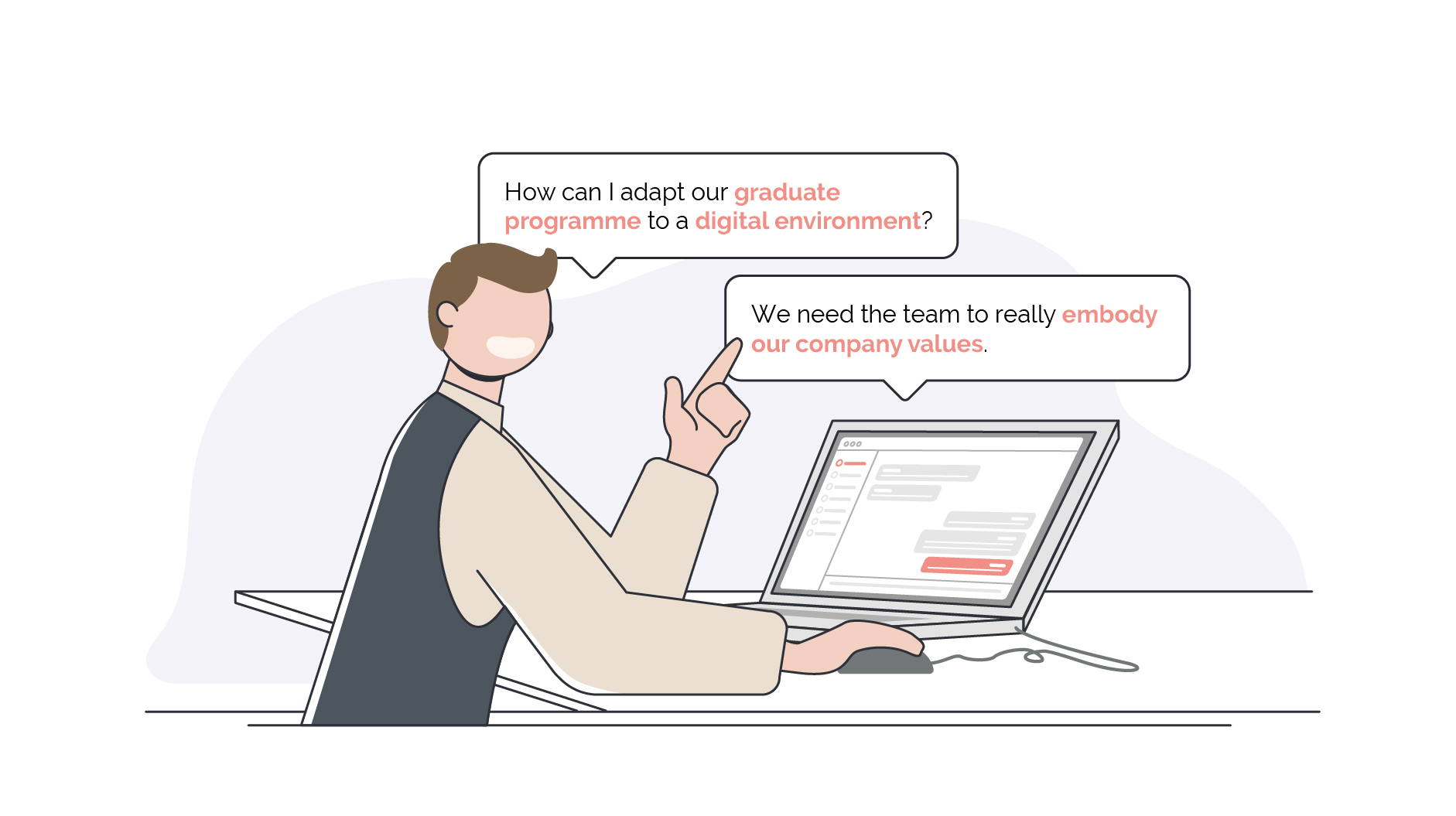
At a time when people have not been able to get out and about with much ease, locations, venues, destinations and organisations dependent on attracting visitors have understandably suffered. Of all the sectors profoundly affected in the last year by the COVID-19 crisis, the hospitality, tourism and culture sector has potentially felt the sting the most.
On a global scale, tourism is the third-largest export category (after fuels and chemicals) and in 2019 accounted for 7% of global trade. Taken from the UNWTO Secretary General’s brief of the unprecedented economic impact of COVID-19, as many as 100 million direct tourism jobs are at risk, including associated industries such as accommodation and food services that provide employment for 144 million workers worldwide. Small businesses (which shoulder 80% of global tourism) are particularly vulnerable.
Within the UK, a Historic England survey on the effects of COVID-19 on the sector, 76% of respondents reported lost business in the short term and 58% had postponed or cancelled income-generating events due to the Coronavirus pandemic. Meanwhile in the three months leading up to June 2020, the arts and entertainment industry saw a nearly 45% reduction in GDP, leading to nearly 70% of workers being furloughed.
Facing the stark impact, the immediate priority is to boost competitiveness and build resilience. In order to strengthen and begin to recover momentum, many groups and organisations will be looking at economic diversification and promotion of domestic and regional tourism where possible. Experts believe this will need to involve advancing innovation and digital transformation, including investment in digital skills and exploration of digital solutions to preserve and promote work and experiences across industries, as well as a means of adapting to what could be a slow return to previous activity.
The question is not just how to reopen. As governments contemplate phased approaches, for some opening as before may not be possible or may not provide the much-needed injection of activity and revenue for a fast recovery. We will most likely be looking at slow progress to avoid the problematic booms that provoke subsequent restrictions. Consequently, many will need to consider alternative experiences or services to bolster their offering, different ways to carefully reconnect with communities, supporters and members, and either reassuring outreach or vastly innovative engagement to attract and appeal to a wide range of attitudes and emotions. Or even a combination of all of the above.
The challenge that continues to weigh on most minds is when people cannot physically come to you, how do you – as a site or destination or city – bring your offering to them? In a hugely competitive market, the pressure is on to do something amazing and do it right, or else face abandonment or rejection. How can you provide valuable, meaningful but exciting experiences that people may be willing to pay for or donate towards as a way to stay afloat, nurture advocacy, and attract participation? The answer may require some strategizing, but by applying imagination and innovation, the results could outlast the current crisis and even provide some futureproofing for a sector already rich in inspiration and attraction.
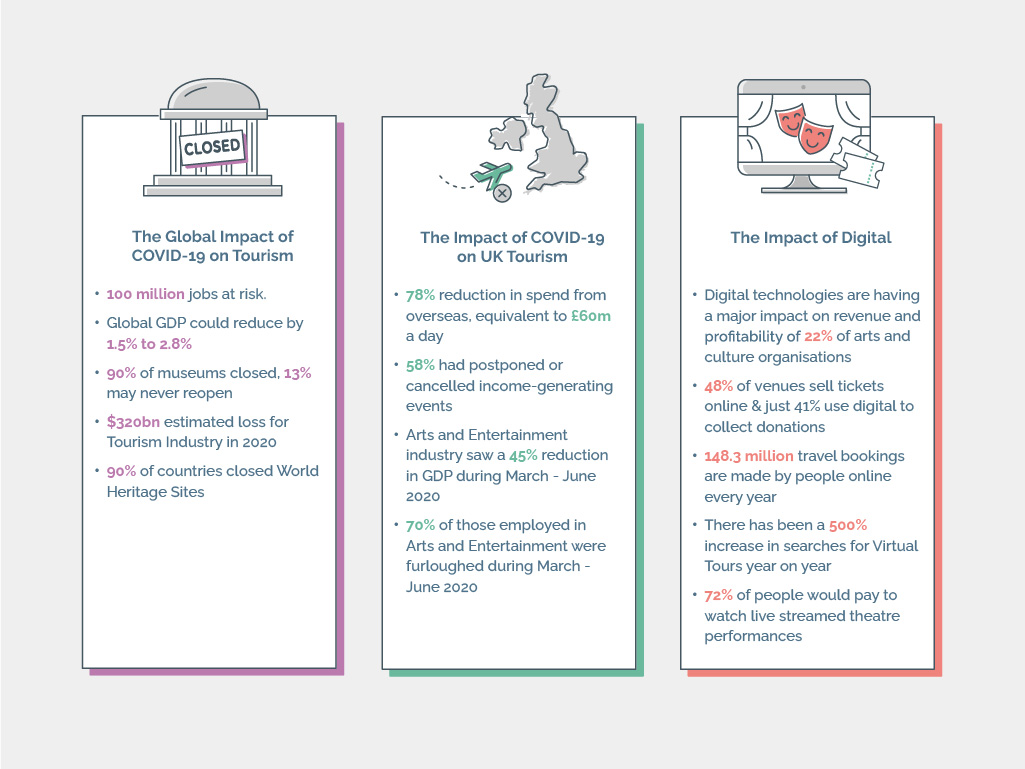
Experiences and Engagement
Let us perhaps start with an easier set of questions: how can we easily reach large audiences? How can we make sure what we create is easily adaptable and even repeatable? The answer is probably already at your fingertips right now. Technology is more powerful, flexible and accessible than ever before, with improvements and new devices and platforms arriving every day. There are more ways to get closer to end users or consumers. More insight into needs and expectations, more possibilities to translate experiences to screens – either wide or palm-sized. And audiences are more than ready to try new ideas. In the UK Gov Digital is Future 2018 survey, 30.6% of adults had participated in some form of digital culture (defined as visiting websites or apps). 60% of consumers reported that they believed experientialism (the use of large-scale projections, holograms, virtual reality or augmented reality) had already become the future of events. Epson’s research “The Experiential Future”, points to how immersive and experiential elements could be the future of retail outlets and the high street with 67% of Millennials more likely to shop in-store if there was an experiential element included, followed by 65% of Generation Z, 58% of Generation X and 52% of Baby Boomers.
These shifts in attitude demonstrate that more audiences are coming to expect technology as a primary vehicle for connecting, promoting, communicating. The next important step is in mastering how to make those digital experiences last longer than a few ephemeral seconds, designing instead to hook consumers, captivate hearts and minds, and nurture lasting, emotional connections through a variety of methods.
When looking to apply this across tourism, hospitality or culture, we need to take into account the expectations of today’s tourists or consumers. In the current situation many organisations find themselves in, the objective is to reignite sparks across different audience groups to get people excited, engaged and feel encouraged, to help kick-start the sector again. How can you influence attitudes to make people who were hoping for a holiday abroad feel equally excited about a staycation? How can you communicate information to reassure around safety measures? What extra incentives are dotted across your offering to draw people back? Or how do you provide a great experience to someone who is not yet comfortable with or able to leave their home or area?
Tourism, or tourism-adjacent products and services are already experiential by nature. The essence of tourism is the development and delivery of experiences to people who wish to see, understand, and experience different destinations or the way people live, work, and enjoy life in those destinations (Ritchie, Tung, & Ritchie, 2011). Given the evaluative and recommendation-based aspects to the sector, tourism organisations (hotels, airlines, booking platforms, destinations, etc) began extensively implementing Customer Engagement strategies in one form or another long before COVID-19, to engage with their customers at various stages of ‘consumption’ (pre, during, post). By looking at it through a Customer Engagement lens, organisations are able to extend the visitor experience beyond the service or visit to provide multiple opportunities to have a positive and meaningful influence on consumer attitudes and behaviour, and create a lasting connection. The same way retail brands look to increase footfall, advocacy, loyalty, and revenue through carefully curated Customer Engagement and Experience strategies, similar principles can work or at least be adapted across tourism. Whether you’re browsing for a new pair of trainers or looking for something different to do this weekend, as a consumer you will naturally turn to your preferred device and surf for the winning product or service that speaks to you – that helps you picture yourself enjoying the end result, that stands for similar values, that provides a seamless browsing experience, that sends relevant, personalised communications when you exchange information, that gives you that value-add feeling. Developing experiences to attract the Digital Tourist, the focus should be the same – considering the end users’ needs or expectations and designing them into the heart of whatever experience or offering you create.
For digital solutions, from virtual reality to 360-degree photographic tours, there are a wealth of options available to the likes of museums, libraries and tourist attractions. However, is recreating the visual in the virtual enough? When you visit a museum, it is a visceral experience, with all of your senses being treated to sights, sounds and smells. You can touch objects, interact with exhibits, listen to the stories behind them and more.
Poorly implemented or irrelevant technology could make all that magic fall flat. However, interweaving an intuitive and attractive design, and integrated, rich user-centric strategy to capture hearts and minds of all backgrounds and interests, different digital functionalities and solutions can help people truly live the experience – and even relive it time and time again.
While you may not be able to touch the skin of a dinosaur via your phone at home, but you can see it come to life and roam through prehistoric jungles. You can listen to a narrator explain to you how they lived, whilst watching them hunt. You can take control of them and explore on your own, discovering new facts as you go. The experience is translated and enhanced, becoming richer and more meaningful than just a marketing tool to raise your profile.
So, what can you weave into the story you want to tell?
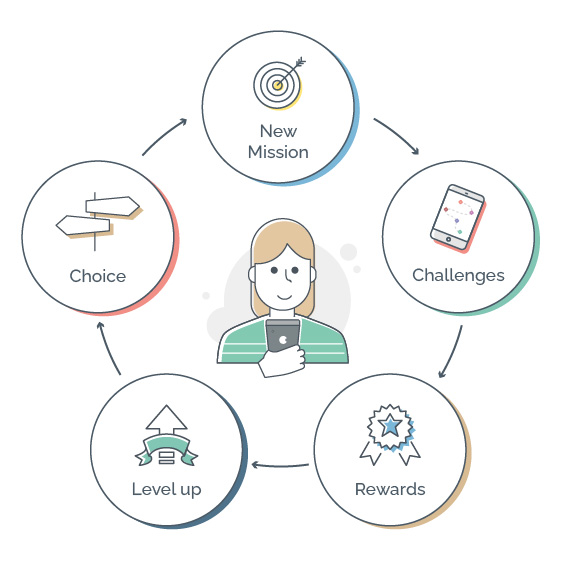
Narratives, Story Telling and Game Design
Designing experiences that focus on strong storytelling can take your users on a journey that is engaging, entertaining and educational. They are elements that allow people to fully immerse themselves in a situation and detach themselves from the daily routines, distractions or even restrictions in their own real world. As a design feature, they really help participants get the most out of both the experience and are a proven method to help improve learning and wider engagement.
Within arts, culture, heritage, tourism and hospitality, storytelling becomes a match made in heaven given there is ample material or existing characters to seek inspiration from. Narratives encourage exploration in both virtual and real spaces; for example, creating intrigue to draw people to different areas of a city, or enticing them off the beaten track to hidden gems. There are even ways to make the participants the protagonists by providing tools to create their own stories, such as sharing their adventures with others on micro-blogging sites like Medium and Instagram, helping to promote and advocate for the experience.
Though story-telling and narratives lend themselves well to the sector, there are many elements of game design that can be woven into creating exciting and engaging experiences. Setting missions that require users to visit (physically or remotely) locations to move the narrative on or earn some kind of reward can drive users to visit new and unexplored places. Providing opportunities to win prizes can keep users coming back. Adding “multiplayer” like social elements, such as group tasks, can create a sense of community allowing them to share their experiences and help each other, without necessarily being physically near each other.
Picture inviting visitors for weekend missions where by downloading an app, they have the chance to immerse themselves in the life of a well known author, setting them missions or challenges that take them around their birthplace, encouraging collaboration and friendly competition, blending quizzes based on their well-known tales with facts from their own life story – and blending local businesses and destinations with the participant’s journey. Visitors leave with more knowledge and appreciation for the area, and the sense of having done much more than just sightseeing.
Immersive Exploration & Virtual Reality
In some ways the pandemic propelled interest in VR and gave it a chance to shake off perceptions of it just being a passing fad or gimmick. Trapped in the four walls of our homes, Virtual Reality is one of the truest definitions of escapism and as it becomes more accessible, the potential continues to grow. There are games to give you a cardio rush, traditional games that engage you in missions and quests, but there are a growing number of experiences that utilise the medium as a way to blend learning, exploration and immersion with more emphasis on ‘reality’. And many feel it is here that the concept of a digital (or virtual) tourist has the potential to flourish into something exciting.
Various destinations have started showcasing locations and attractions through VR in recent years to diversify their marketing approaches. Groups such as the German National Tourist Board adopted VR as a marketing tool, raising the profile of its attractions and piquing interest as they take Oculus Rift viewers on 360º video tours across the country. It is arguably a more competitive approach to garnering interest, but the impact VR can have as a marketing tool that converts fun videos into ROI is still yet to be seen. What is evident is the demand that exists, combined with people’s need to explore – albeit virtually for now. Searches related to “virtual tours” have grown globally by over 500% year over year suggesting people may even prefer alternatives to in-person tours until they feel safe or ready again.
The benefit of developing technological solutions such as VR is that, if done well to ensure adoption and usage, they can be a cost-effective and powerful way to help clients feel more comfortable and more willing to travel. From a practical point of view, VR can be highly effective for learning settings. For cities, airlines and airports, hotels, or larger organisations looking to incentivise travellers, VR experiences can help set expectations and improve understanding before they go to book anything, for instance explaining to users what health and safety measures are now in place to keep them comfortable. For specific destinations, such as museums or similar tourist attractions, VR could bring an experience to life for people not yet ready to leave the comfort of home but who are missing that sense of adventure or discovery. Virtual Reality as a design mechanic has great potential, but on its own all you are really showing is an immersive video experience. By adding motivational and behavioural design to it, you can create something that truly hooks the imagination and interest of participants.
Imagine visiting a virtual library, where you can not only read the books on the shelves, but you can hear from their authors, learn how the book came to be, what got left out, what they might have changed.
You can take the design much further, by creating video or live-action role-play games that add to a visitor or users overall enjoyment of their experience. These could be stand-alone games designed to attract people or fully integrated to augment the existing physical or virtual experiences.
When you open the book in the libraries app, the characters could come to life – playing out the story in front of you and then offering you a chance to decide how the story branches. Do you follow the original narrative, or make changes and see how the ending is altered?
All of this is made possible with the use of the right technology and an understanding of where it is appropriate to use it. Not only does this open up attractions to wider audiences, for example bringing museums into classrooms around the world for interactive lessons, but it also creates an opportunity for augmented and enhanced physical experiences when visitors are once again allowed to come through the doors.
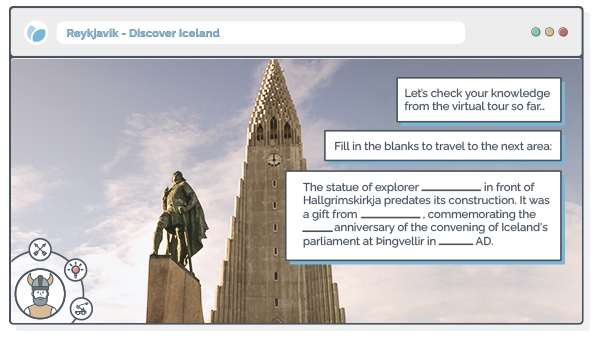
Personalisation and User Centricity
Finally, but possibly most importantly, personalisation. As we come out of various lockdowns and restrictions to our lives, something we will likely want more of is control of how we enjoy our new freedom. When this comes to what we are going to do with our spare time, it is an opportunity for attractions to provide something different and interesting for potential visitors and tourists, physical or virtual, by offering as much flexibility and personalisation of the experience as possible.
The development of apps that work as virtual tour guides, offering location-based tips on exciting sights to visit near them will give visitors the chance to start to build their own custom tours and outings. You can then allow users to choose the types of exhibits or attractions they are interested in and further personalise their experience by only suggesting things that fit those preferences.
Make it as easy as possible for people to find an experience that they may enjoy by offering related recommendations or creating easily navigable apps or websites that can take their preferences and offer focused suggestions. Even before the pandemic, up to 83% of customers felt that said they felt brands should offer them suggestions based on their personal preferences.
More than “A Day Out”
Post COVID-19, people will naturally want to get out more and travel again but may well be nervous of doing so. At the same time, those leading within the culture, tourism and hospitality sector will be determined to revive activity and re-establish some form of normality and security for thousands of organisations, destinations and venues. It will be a huge challenge, but simultaneously could be a grand opportunity for the industry to showcase just what they have on offer for a range of interests, needs and abilities.
In the UK alone, when asked what type of vacation they expect to take in the next 12 months 38% of respondents said they now expected to take a domestic vacation and 20% expected to take a staycation in their local area (Google Trends 2020). There have also been shifts in consumer demand around the specific location of domestic vacations. While demand for beach destinations has remained consistently high, in August this year, UK searches for ‘country holiday’ surpassed the term ‘city break’ for the first time in over 10 years. The desire and appetite for escapes, exploration and relaxation is undoubtedly there, but collectively we need to be ready to navigate and adapt to new expectations. Creating alterative, parallel, or more accessible experiences as part of a support network will be imperative to help the sector create momentum again in the long run. Designed with long lasting engagement in mind, they will also have the capacity to futureproof against any more bumps the road ahead brings. Designed with users in mind, you’re creating experiences that will be more diverse and inclusive and accessible than ever before.
The use of the right technology can support all stages of accessibility as we all initially emerge from lockdowns or get used to new circumstances and habits. Digital can play a powerful role in feeding the need for exploration, learning, inspiration, excitement, and can step in to fill in gaps across experiences, keep connections and channels open for broader communities, and can empower the brilliant teams behind some of our beloved destinations, projecting the stories they have to tell to all who are ready to listen.
All relationships take some effort if you want them to work. The relationships we have with brands, our workplaces, or the community around us, are no exception. Originally, these relationships were purely transactional. “If I show up 9-5, I’ll get paid”. “I go to the shops to buy food or clothes”. Brands then learnt that profitability lay in convincing people to buy more than one item of clothing a year, and employers came to see that their employees held much more potential for innovation and development when they felt motivated to go beyond the basic 9-5 expectations. Nurturing the connection or perception that people had of a brand, business or organisation became much more beneficial to encourage heightened participation or performance.
However, today, there are countless options, distractions, recommendations, and information available to audiences which has provoked a shift in their expectations. One-way, push-engagement is no longer enough. Audiences need more empathetic, authentic and relevant prompts from brand communications in order to earn their trust and loyalty, knowing that they do not have to settle for a poor experience.
To really stand out and survive the ebbs and flows, the key is in building sustainable engagement, sustainable reactions and sustainable participation – whether you are trying to attract customers, encourage employees or inspire citizens. Experiences that create a positive, lasting emotional attachment that drive people to return, trust, commit, and act.
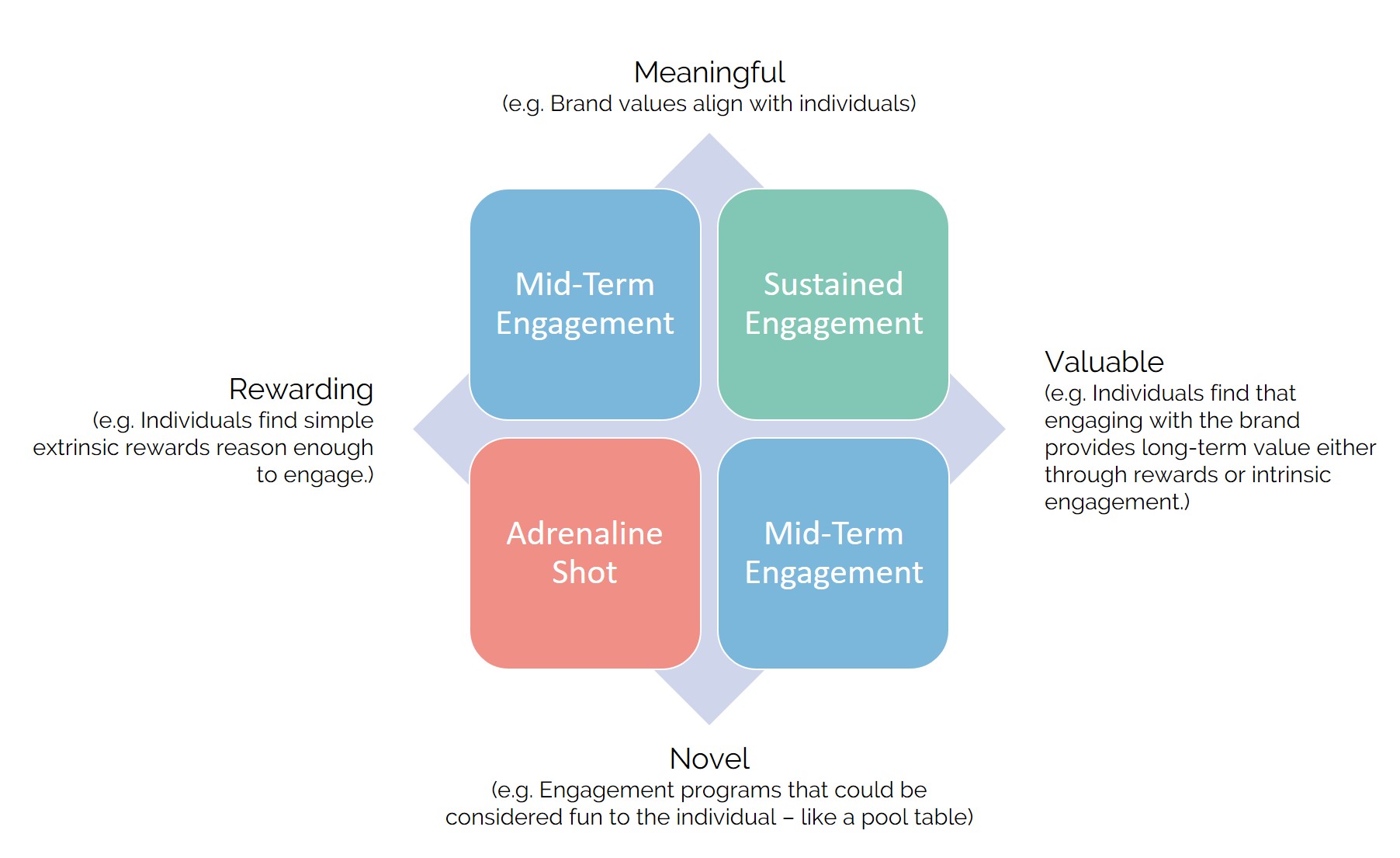
For example, the key to sustaining customer engagement, as with employee engagement or civic engagement, is to put the customer at the centre of the experience. Given how much customer data and information is collected today, it is completely fair to expect brands to repay the trust the consumer places in them by using that insight to create greater value in their everyday experiences, touchpoints, and interactions. Provide meaningful rewards for customer support, patience, and loyalty when it feels right to them, not only once they’ve spent money. Provide omnichannel experiences that demonstrate personalisation, relevance, and how the brands values align with what is important to the consumer, all contributing to a deeper, emotional connection and a greater likelihood of sustained advocacy and business. Reflecting a world where expectations are shifting, on average around 71% of consumers consider it important that brands uphold values that they have an emotional attachment to.
You can make meaningful, sustainable change that looks and feels innovative for everyone involved without diverging from company objectives, but that crucially addresses what your employees are telling you.
In the workplace, the challenges may feel different but the person-centric approach to sustaining engagement does not change. According to Gallup, up to 85% of employees are disengaged with work. Employee Engagement has held a range of definitions over time, encapsulating everything from Ping-Pong Tables, Taco Tuesdays and Friday Drinks, to running surveys, to renovating office spaces with biophilic design. All positive steps in the right direction for fostering communities and making the workplace somewhere positive to belong. But we would argue not meaningful, not really engagement, and definitely not sustainable. We categorise these gestures as ‘adrenaline shots’ that work to temporarily boost good feelings, but as with a sugar rush, can lead to a crash afterwards. It may seem a generous and forward-thinking idea, but it is often a poorly planned “knee-jerk” reaction that fails to address the deeper issues that may be affecting the feelings of the employees or why there may be a low level of engagement. Ping-pong won’t encourage employees to go the extra mile at the end of the month every month or help them understand the collective company goals. Sustained experiences that support how they work, tackle issues they have raised in employee surveys or make processes easier to take on, go towards making employees feel you’ve taken time to see what usually slows them down or causes a disconnect.
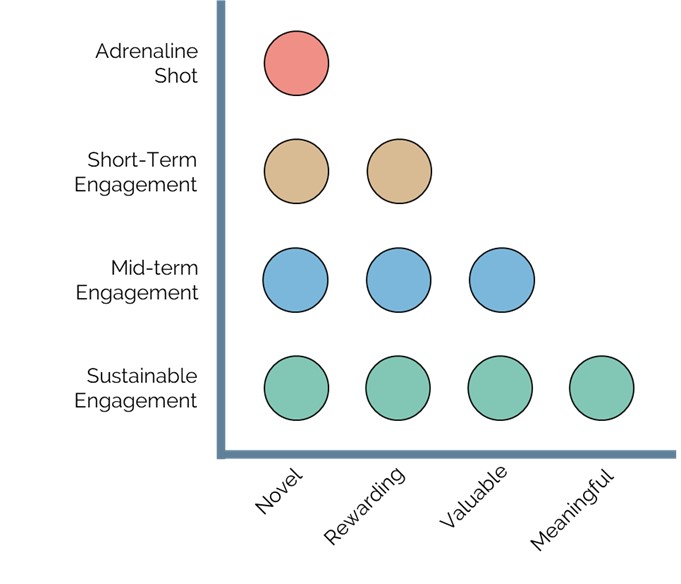
What all sustainable engagement shares at its core is the need to create user centric experiences that they find meaningful and valuable. They need to feel that they are understood, trusted, listened to and that any kind of reward, be it intrinsic or extrinsic, is tailored to their specific wants and needs, not just a generic token. Striking the correct balance is not easy, it requires a deep understanding of the individual at the centre of the experience as well as a way to deliver the experience. It is also not a one-shot, one-size fits all solution. You need to view engagement as a long-term strategy rather than a one-off quick-fix novelty if you want to deliver on business objectives and change behaviours.
But once you’ve cracked the equation, it’s a wheel that will keep turning, sustainably supporting where you need to go.
This piece was created in collaboration with Epion and also appears on their blog found here.
How does anyone even begin to ‘round-up’ the year we’ve all had? In our personal and professional lives, most of us have experienced such vast challenges and significant change that it is hard to believe it has been 12 months and not 24. Though we may be turning a new page as we move to the new year, it is not an entirely new story, and in 2021 many businesses will most likely continue to grapple with different ups-and-downs and the effects of 2020.
That said, we believe what also lies ahead is an opportunity to make a real difference by reassessing and improving approaches, focussing on the people at the heart of businesses, communities, organisations, and society, to achieve success in spite of uncertainty.
So instead of rounding up 2020 as if the story were over, we thought we’d look back on the themes and pieces that most appealed to people’s needs and interests over the year. Reflection and food for thought, as the collective journey towards new approaches, strategies and innovation continues into 2021 and beyond.
-
Keeping Teams Connected & Empowered
This year teams had to act and adapt quickly to new circumstances, conflicting priorities, and different strategies. A need like never before to think creatively and innovatively in how challenges were met. With many moving to remote working or facing heightened demand, lots of us looked for ways to keep employees feeling productive, fulfilled, and motivated – through digital solutions.
In 2021, there will no doubt be a new round of challenges to face in supporting and sustaining an engaged, committed, and productive workforce in what will still be difficult business conditions. Here are our 3 most popular posts from this year looking at employee engagement, to help spark ideas for 2021:
-
Customer Care, Concern and Connection
In a recent study, 70% of European based executives stated that the current coronavirus pandemic was accelerating the pace of their digital transformation. This year saw brands across all sectors make herculean efforts to try and stay connected to their customers, some even diversifying the services they offered in order to sustain the customer bond. Digital experiences inevitably became the only vehicle for staying in touch, and while technology is amazing because of its reach and flexibility, it is just a vehicle at the end of the day.
It is people who we want to connect to, build relationships with, and learn from their motivations, reactions, and needs. Human crises require human responses.
Is 2021 the year to flip our thinking on digital transformation and focus in on how it can deliver better connection, empathy, and engagement? Here are our 3 most popular posts from this year that looked at building better relationships and engagement with customers:
-
Future Values
Over these past few months, we have all had time to think and reflect on the way we live our lives. Crises often have the effect of bringing our core values into focus, and by having a number of our old routines and habits taken away from us, we’ve maybe been reminded of what we think is important. Furthermore, more than ever before people are expecting the brands around them to stand for something. Businesses are now being pushed beyond their classic interests to become advocates for a better society.
Euromonitor’s 2020 Sustainability Survey found that COVID-19 has brought social purpose to the fore, with two thirds of surveyed companies defining sustainability as “supporting local communities”, a 15% increase compared to the previous year. Accenture reports 62% of customers want companies to take a stand on current and broadly relevant issues like sustainability, transparency or fair employment practices.
As we all reassess what practices and approaches we want to represent our values in 2021, here are our 3 most popular posts on the emerging power of values and ethics in society.
RAMP, Intrinsic vs Extrinsic Motivation, Gamification…
What are we talking about?
Our Gamification Guru, Andrzej Marczewski, breaks down some of the theories and concepts we often talk about and use in our Engagement Solutions.
Interested in how Gamification or Behavioural Science could help your organisation achieve objectives and boost engagement?
3 responses for 3 common Employee Engagement challenges
A challenge we come across when designing our engagement solutions, is how often teams focussed on Employee Engagement, People, HR or Talent struggle to pinpoint the exact change they want to make. They’ve run the surveys, got the results, can see there’s room for improvement, but don’t know where or how to begin. This is understandable – the problem can feel intangible, especially as engagement survey responses are mostly fuelled by emotions. Improving the emotional wellbeing, connection, commitment, motivation, and ultimately performance across a business doesn’t happen overnight. You can, however, make meaningful, sustainable change that looks and feels innovative for everyone involved without diverging from company objectives, but that crucially addresses what your employees are telling you.
To help demystify these solutions and show that it can be easily achieved, we thought we’d break down 3 common Engagement Survey trends and their responses.
Social Management & Preventing Detachment
As we find ourselves working more from home, or on the move, it can be very difficult to feel “part” of something. Our sense of belonging and purpose can become diluted. Providing ways for employees to communicate and socialise with each other is essential, something we have spoken about a number of times.
What is the benefit in addressing this? The feeling of isolation that can often result from working remotely can be damaging not just for your sense of belonging within a team, but also for your mental health. From a business perspective, having people not in the same building or room can reduce the opportunities for fast interactions and iterations of ideas, serendipitous conversations in the kitchen and those water cooler moments. They may feel like minor aspects of business-as-usual, but all of these moments can often lead to creative sparks being ignited.
Employers who enforce a high level of social connection (with co-workers and the wider external community, perhaps through nudges etc) benefit from a 64% high engagement rate of employees.
Idea Management & Employee Voice
It is not uncommon for employees to feel voiceless, especially in large organisations, in the face of change, or when their roles focus on day to day operations rather than strategic objectives. This can be incredibly demotivating and if left unaddressed can drive a wedge between employee groups and the organisation. Employees who don’t believe their company will act on their feedback are 7x more likely to be disengaged than those who do. It gets even worse when employees are asked for their opinion, but nothing ever happens with the ideas they provide. Not only does this make them feel they can’t be heard, but that when they are – what they say has little to no value. Having the “What’s the point?” effect.
What is the benefit in addressing this? Companies often preach that their employees are their most important asset. Sometimes they don’t realise just how true this is. Employees are the face of a brand, they manage customer problems, and live and breathe the products or services all day every day. They are often in a good position to resolve common issues or ideate improvements. Encourage knowledge sharing, and inclusivity across ongoing projects. By supporting employees to be collaborators and facilitators, you may well find you’ve created teams of innovators.
Places where “employees have influence” get longer tenures out of their workers. After three years, there’s a 47% chance of an employee sticking with them. At companies seen as less empowering, employees only have a 35% chance of celebrating their three-year work anniversary.
Recognition Management & Boosting Commitment
Another big issue that employees often talk about is not feeling recognised for the contributions they make to the company and for each other. 82% of employees are happier when they’re recognised at work. Especially meaningful at times where people are maybe going above and beyond the call of duty in order to get a project done on time, or even just when you can see a colleague is having a full-on week. This does not just mean offering financial recognition, like a bonus or vouchers. Extrinsic rewards can sometimes have the opposite effect; your work on this project after hours is worth £25 to spend on Amazon. Doesn’t feel great does it?
What is the benefit in addressing this? Feeling recognised fosters a sense of community, that the people around you appreciate you for your skills, your aptitude, and all you do. Celebrating wins, boosting visibility of people’s contributions, providing spaces for people to share and receive praise can go a long way to improving community spirit and how fulfilled people feel in their role. Employees who are confident that their company recognises their individual contribution are more likely to keep contributing and going the extra mile.
When asked what would motivate them to remain with their current employer, respondents cited interesting work (74 percent) and recognition and rewards (69 percent) as the top factors.
Addressing the Problem
Having identified three core areas to work on (employee responses & needs) we can start to design the solutions to improve the employee experience, thus moving the dial on overall employee engagement. Myth buster time: these solutions don’t have to be complex, distracting platforms that sit apart from everyday work! We believe in simply enhancing common processes and approaches to deliver better results. So, let’s give it a go!
- Connection: Platforms that mimic social networks can feel familiar and encourage more informal conversations. But presenting another channel for communicating isn’t always as helpful as it may initially seem. When you’re working on your own, away from the office, seeing you have 77 notifications across 8 different work-based applications can cause more chaos than connection as you stress over which conversation to answer first or what channel has genuine work-related information.
Instead offer a solution that could mimic the workplace while running in the background; where you know which break out zone to head to when you’re in need of some friendly, non-work related chat, or alternatively pop into the ideation area when you’ve hit the wall and you want to bounce some ideas off people. A tutorial that could run for the first few weeks could also help guide people on how to get the most out of the new tool (and avoid awkward misuse or over-sharing moments), and even help identify and source internal champions to help engage and encourage others appropriately. - Voice: Speaking of ideas, an effective way to provide all employees with a voice is to implement digital ideation systems, a place where employees can submit ideas they feel will benefit the organisation. The system needs to be available to everyone so that they can submit an idea. Other employees would then be able to see these ideas, comment on them and vote on them. The voting is important to help surface the best ideas. Voting could be in rounds, with gated progress, so that ideas need to pass certain checkpoints to be seen by wider or more senior audiences. Ideas that are chosen to be developed can them be collaboratively worked on and developed further by teams within the system. A system like this can be open all year around for general ideas but could also be used to help solve specific problems set out by the company. This kind of crowd sourced solution development can be incredibly effective and make everyone feel they have a chance to be heard.
- Recognition: And finally, providing a space within the solution to manage and showcase recognition would round off our three key issues. It would need to include more than top down recognition, although providing prompts like “Who’s really impressed you this week?” could help facilitate better relations between teams and managers. But it’s also about enabling peer to peer, informal, and cross departmental or regional recognition. Having this integrated alongside the social and ideation threads would only do more to bring communities together, knowing you can say ‘thank you’ or ‘great work’ from afar.
Employees could recognise each other for jobs well done, pitching in when they didn’t need to, displaying company values, and each could be assigned individual gestures or commendations depending on the message being sent. Virtual applause for job well done that could be used more frequently, a high five for great teamwork, specific badges for excellent customer service or innovation, etc. These awards could be displayed on the individual’s profile, as references or reminders of their performance, and subtle encouragement to work towards attaining more. The profiles could even be used as a references within appraisals or internal reviews, adding more meaning to everyday work and wins.
Today’s consumer no longer wants to be guided by merely transactional impulses. They want to find more, they look for new or enhanced experiences, they want to feel unique. Subsequently, the retail sector cannot settle for an occasional customer – a ‘peruser’, a browser, a surfer. Brands are in a battle to become that “go-to name”, the first place you think of when you need or want something or the feeling takes you. Somewhere that welcomes you and facilitates your experience each time. How can a brand level up and achieve this coveted status?
In a simple purchase process, the customer perceives a need or interest, browses options, checks offers and makes a decision. The tendency is to settle on a desired product or service and then weigh up the price, or value for money. In this experience if attention to customer retention, engagement or loyalty is weak, should any one of the items in the equation fail you’ve lost a customer, their recommendation or influence, and any chance of a return visit.
Simple loyalty strategies work on the basis of generating a reason or incentive to return to the business, for dependable recurring profitability. Customers appreciate the benefits that the brand gives them for their support and this fosters a sort of reciprocal dependency. You like the brand and the brand likes you. But can we really call this relationship sustainable or even rewarding? How protected is it from alternatives or distractions?
What if we integrated a more focussed Customer Engagement strategy within the experience? Here, the brand introduces elements of intrinsic motivation for the customer: incentives and rewards that speak to the individual’s wants and needs, generating a deeper emotional connection between brand and consumer. At each touchpoint between customer and brand, the offerings are more in tune with the customer’s profile, meaning the purchasing or browsing experience is more satisfying, increasing the individual’s commitment to the process, purchase, and return. Your recommendation will be positive.
The objective is that neither the process nor the relationship end at the point of sale. The brand can continue interfacing or interacting with customers in order to keep building their understanding of needs and tendencies, strengthening relationships with personalised communications and offers, collecting feedback and (importantly) acting upon it to demonstrate more meaningful value for customers than just the product or service offering. In turn, consumers feel recognised and become more involved in the brand beyond their initial browsing interest – advocating willingly for what the brand represents or means to them and seeking more positive experiences as the bond continues to grow over time. Customer retained and engaged. Relationship transformed.
UK Offices
Newcastle
The Core 5.22
Newcastle Helix
Bath Lane
Newcastle upon Tyne
NE4 5TF
+44 191 495 7340
Spain Offices
Madrid
Av. de Bruselas, 13
Ed. América
28108 Alcobendas
+34 91 425 86 57


